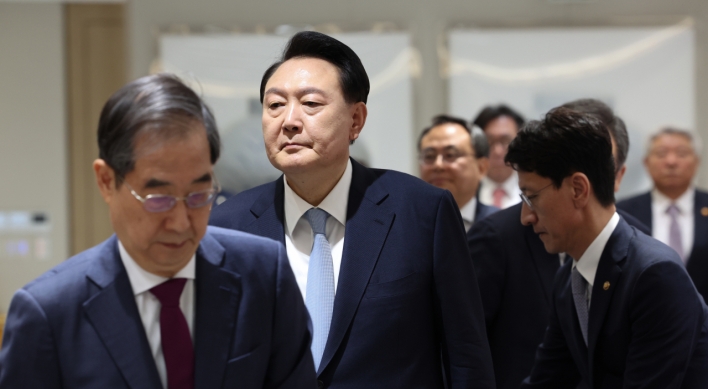A low birthrate and rapidly aging population is projected to pull South Korea’s economic growth rate from second place to ninth among Organization for Economic Cooperation and Development members by 2026.
A report by the club of 34 major economies said the annual rate of growth in the South Korean economy will fall to 2.4 percent after 2026, a sharp downturn from its 6.2 percent expansion in 2010, second-highest in the OECD.
In the short term, the OECD predicts that the local economy will continue to show above-average growth.
Between 2010 and 2015, it expected Korea to grow at an annual pace of 4.3 percent, behind only Chile at 4.8 percent and Israel at 4.4 percent among OECD members.
It also forecast that the Korean economy will expand 3.8 percent per year between 2016 and 2026.
But the forecast dropped to 2.4 percent during the years beyond that, putting it at ninth.
The potential growth rate here refers to the maximum expansion an economy is capable of accomplishing without building inflationary pressure.
The state-run Korea Development Institute said the country’s potential growth rate fell to 4.3 percent from the pre-crisis level of mid-4 percent range.
The country’s feeble birthrate and aging population in turn spur welfare expenditures. A research team at Sungkyunkwan University said welfare spending for Asia’s fourth-largest economy will account for almost half of its gross domestic product by 2050. In a report released earlier this month, it noted that welfare took up about 3 percent of the GDP in 1990 but said the figure will jump to 45.6 percent in 2050.
The country spent $110 billion on social welfare last year, which the team estimated will grow to $2 trillion in 40 years time.
The team advised policymakers to increase the tax burden on working-age people to more than 40 percent in 2050.
By Cynthia J. Kim (cynthiak@heraldcorp.com)
韓 저출산 때문에 장기 성장률 OECD 9위로 하락
]
잠재성장률, 중기 3위 → 장기 7위
지난해 경제협력개발기구(OECD) 2위를 기록했던 한국의 경제성장률이 장기로는 9위까지 내려설 것으로 전망됐다.
저출산ㆍ고령화에 따라 잠재성장률도 2015년까지는 세 번째로 높겠으나 이후 10 년동안 7위로 밀려날 것으로 예측됐다.
29일 OECD가 최근 발간한 '경제전망(Economic Outlook)' 보고서에 따르면 지난 해 한국의 국내총생산(GDP) 성장률 6.2%는 34개 회원국 가운데 터키(8.9%)에 이어 2 위를 기록했다.
또 한국의 중기(2010~2015년) 경제성장률 전망치는 4.3%로 칠레(4.8%)와 이스라 엘(4.4%)에 이어 세 번째로 높았다.
그러나 한국의 장기(2016~2026년) 성장률 전망치는 2.4%로 크게 낮아지면서 순 위도 9위로 밀려났다.
장기 성장률 전망치는 아일랜드(3.5%)가 가장 높았고 이스라엘(3.4%), 칠레(3.0 %), 멕시코(3.0%), 호주(2.9%), 노르웨이(2.7%), 스페인(2.7%), 포르투갈(2.5%) 등 이 뒤를 이었다.
OECD가 지난해 11월 발간한 '경제전망'과 견줘보면 한국의 중기 성장률 전망치 는 바뀌지 않았고 장기 전망치는 높아졌으며 순위도 중기는 낮아지고 장기는 높아졌 다.
지난해 11월 보고서에서는 한국의 2010~2015년 성장률 예상치는 4.3%로 칠레와 함께 1위를 기록하고 2016~2025년은 1.8%로 17위에 머물 것으로 예측됐다.
아울러 한국의 잠재성장률은 2010~2015년에는 3.8%로 칠레(4.1%)와 이스라엘(4.1%)에 이어 3위를 기록하겠지만 2016~2026년에는 2.4%로 떨어지면서 순위는 7위로 밀려날 것으로 예상됐다.
장기 잠재성장률은 이스라엘이 3.4%로 가장 높았고 아일랜드(3.3%), 멕시코(3.0 %), 칠레(3.0%), 호주(2.8%), 노르웨이(2.7%) 등의 순으로 나타났다.
잠재성장률이란 가용한 생산자원을 활용해 도달할 수 있는 지속가능한 최대한의 산출수준인 잠재산출의 증가속도이며 국가 경제가 안정적으로 도달할 수 있는 중장기 성장추세를 뜻한다.
한국개발연구원(KDI)에 따르면 한국의 잠재성장률은 글로벌 금융위기 이전인 20 01~2007년에는 4% 중반이었으나 2008년 이후에는 4% 초반으로 낮아졌다.
KDI는 최근 잠재성장률을 분석한 결과 고령화에 따른 인구구조 변화 등에 따라 2010년대에 접어들면 잠재성장률이 4% 초반으로 낮아질 것이라는 기존의 전망과 일치했다고 밝혔다.
한국의 잠재성장률이 다른 국가에 비해 크게 낮아지는 이유는 저출산ㆍ고령화다 . 빠른 인구 고령화로 노동력 투입 위주의 성장에는 한계가 있기 때문이다.
OECD는 한국의 잠재노동생산성 증가율이 2010~2015년에는 2.8%로 슬로바키아(3.5%), 에스토니아(3.0%)에 이어 3위로 전망했으나 2016~2026년에는 6위(2.2%)로 낮아 질 것으로 내다봤다.
KDI 이재준 부연구위원은 "가용한 노동력의 질과 활용도를 높이고 지속적인 규제개혁과 기업환경 개선 등 생산성을 높일 수 있는 방안을 종합적으로 추진해야 한다"고 말했다.
(연합뉴스)








![[KH Explains] How should Korea adjust its trade defenses against Chinese EVs?](http://res.heraldm.com/phpwas/restmb_idxmake.php?idx=644&simg=/content/image/2024/04/15/20240415050562_0.jpg&u=20240415144419)










